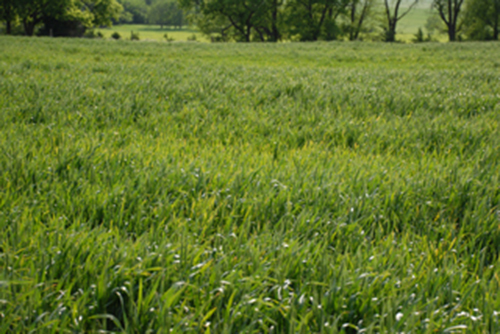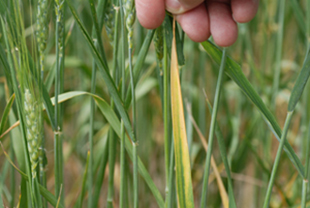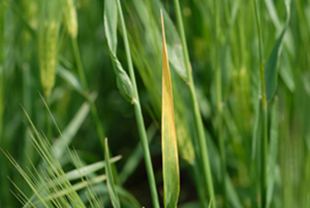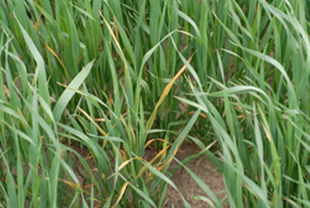G1823
Yellow Dwarf of Wheat, Barley, and Oats
Yellow dwarf is considered the most economically devastating virus disease of small grains worldwide. Outbreaks occasionally reach epidemic proportions in some parts of Nebraska, as occurred in wheat and oats in 2007 and 2011. The epidemiology of yellow dwarf and its effect on yield have yet to be studied in Nebraska. This NebGuide’s information is based on observations of yellow dwarf in Nebraska wheat, barley, and oat fields or research plots since 2007 and on published research conducted elsewhere.
Stephen N. Wegulo, Extension Plant Pathologist
Gary L. Hein, Entomologist
- Symptoms
- Disease Occurrence and Spread
- Management
- Summary of Management Methods for Yellow Dwarf
- Acknowledgment
Yellow dwarf is caused by two viruses belonging to the family Luteoviridae. They are barley yellow dwarf virus (BYDV) and cereal yellow dwarf virus (CYDV). Six species of BYDV and one species of CYDV are recognized and form a virus complex that causes yellow dwarf in small grain cereals. Yellow dwarf viruses (YDVs) are transmitted in nature only by aphids. The disease results from a complex interaction between the viruses in this complex, multiple aphid vector species, small grain cereal and grass hosts, and the environment. Some aphid species preferentially transmit certain virus species within the complex. More than 20 aphid species can transmit YDVs; however, only four aphid species are primarily responsible for vectoring the viruses in Nebraska. YDVs have a wide plant host range. They can infect over 80 species of annual and perennial grasses including barley, corn, oats, rye, and wheat, but yield impacts are restricted to wheat, barley, and oats. Perennial and annual grasses can serve as reservoirs of YDVs. Hence, these grasses can play an important role in the persistence of YDVs and their transmission to cereal crops.
Symptoms
Symptoms of yellow dwarf are highly variable and can be confused with those of wheat streak mosaic, nutrient deficiency, root and crown diseases, and environmental stresses. A definitive diagnosis requires a laboratory test such as the enzyme-linked immunosorbent assay (ELISA). This is a serological test in which an antibody specific to a virus carries with it an enzyme that releases a colored compound on reaction with a substrate. Release of the colored compound confirms presence of the virus.
Yellow dwarf is tentatively diagnosed in the field by the presence of aphids, leaf discoloration, and stunted plants grouped singly or in small patches (Figure 1). Typically, leaf discoloration in shades of yellow, red, or purple occurs from the tip to the base or from the margin to the midrib.
 |
Figure 1. Wheat stunted by BYD. |
- In wheat, leaves first appear pale yellow (Figure 2). Tissues immediately adjacent to the midrib may remain green longer. Depending on the wheat cultivar and cooler temperatures, a red-to-purple discoloration may accompany the yellowing (Figure 3).
- In barley, leaves develop a bright golden-yellow color (Figure 4). Necrotic brown flecking or spotting may accompany the yellowing.
- In oats, a distinctive red-to-purple discoloration usually occurs on leaves, but various shades of yellow, reddish-orange, reddish-brown, or purple may be seen (Figure 5).
 |
 |
|
Figure 2. Yellowing of a wheat leaf caused by BYD virus infection. |
Figure 3. Red-to-purple discoloration on a wheat leaf caused by BYD virus infection. |
|
 |
 |
|
Figure 4. Bright golden yellowing on a barley leaf caused by BYD virus infection. |
Figure 5. Leaf discoloration on oats caused by BYD virus infection. |
Infection during the seedling stages of any of the cereal grains may result in severe stunting, reduced tillering, bright yellowing or reddening of older leaves, delayed heading or ripening, increased sterility, and fewer and lighter-weight kernels.
Post-seedling infections are progressively less severe to the point where only the upper leaves, or the flag leaves, show discoloration. Mild infections may result in no discoloration and little or no yield loss.
Leaves on infected plants are shorter, stiffer, and more erect than normal. The flag leaf may be severely shortened. Root systems are reduced and diseased plants are more easily pulled than healthy plants.
Stunted plants result from failure of the stem internode to elongate. This leads to a “telescoped” plant where the leaves may unfurl before fully emerging from the sheath of the previous leaf. Infected plants are “dwarfs” and have lost their normal conformation. Later the head, or panicle, may not emerge fully or properly.
Patterns of yellow dwarf in a field may be random within the crop or appear as circular or angular patches which reflect the aphid vectors’ pattern of movement. Many of the infected plants ripen prematurely, after which they may be invaded by sooty molds. These molds give a dirty appearance to the plants and may reduce the germination rate of harvested seed.
Don’t use symptom expression of the plants as a predictor of the eventual yield impact. Yellow dwarf yield impact is most severe if plants are infected during the seedling stage. Research shows that severe fall infections of winter wheat may result in 25-36 percent yield loss. Smaller yield losses may result if infections occur in the later growth stages or are sparse in the field.
Disease Occurrence and Spread
The most important vectors of YDVs in Nebraska are the bird-cherry oat aphid (Rhopalosiphum padi), the corn leaf aphid (R. maidis), the English grain aphid (Sitobion avenae), and the greenbug (Schizaphis graminum). For identification and life-cycle information on these aphids, see NebGuide G1284, Cereal Aphids. The bird-cherry oat and the English grain aphid are the most important carriers of the YDVs in oats.
YDVs overwinter in infected winter cereals, and in wild and cultivated grasses. Perennial grasses, such as bluegrass, orchardgrass, tall fescue, and little bluestem, may also serve as reservoirs. In most areas, winter cereals are more important than wild grasses as virus sources for infection of spring grains. Many native grass species have grown next to cereal grains in Nebraska for many years without causing serious outbreaks of the disease.
Oats and barley are very susceptible to YDVs. If planted late for soil cover, wind erosion control, forage, or regrown as volunteer, often they are heavily infected. Therefore, they can be an important local source for migration of both aphids and YDVs into adjacent fall-planted wheat. If these crops act as a green bridge (are still green when winter wheat emerges in the fall), infection by YDVs can result in severe epidemics.
Aphids acquire the viruses by feeding on infected plants. Once acquired, the aphid remains a carrier of the virus for life. The time taken by an aphid to acquire virus from an infected plant is known as the acquisition access period (AAP) and the time taken by an aphid to inoculate virus into a healthy plant is known as the inoculation access period (IAP). The minimum AAP or IAP ranges between 15 and 60 minutes. The efficiency of virus transmission to healthy plants increases with the AAP, with an optimum AAP of 24 to 48 hours. Virus transmission efficiency also increases with the IAP, with an optimum IAP of 24 hours.
Virus spread depends entirely on aphid movement. A very active aphid that feeds for short periods on different plants is a more harmful carrier than several stationary aphids.
Epidemics of yellow dwarf in Nebraska normally are caused by passive migrations of winged aphid vectors carried from south to north by low-level jet winds. Other aphids acquire the viruses in the spring by feeding on infected cereals and grasses during migration. The viruses and aphids also carry over the summer in volunteer cereals and weedy grasses, and cause fall infection of winter wheat.
The biology and behavior of these aphid vectors in Nebraska are not well-known. Historically, they have usually over-wintered farther south under milder winter conditions. However, recently they occasionally have been found to overwinter in parts of Nebraska during mild winters. The effects of a warming climate that allows these insects to regularly overwinter are unknown, but will likely increase the incidence of yellow dwarf in Nebraska.
Damaging outbreaks of the disease are most likely to occur in cool, moist seasons that favor grass and cereal growth as well as aphid reproduction and migration. A driving rain may spread aphids, but also reduce their population.
Management
Seeding dates: In the fall, early-planted winter wheat and barley have a greater risk of virus infection. Aphid vectors actively move in the agroecosystem during the early fall as summer crops and grasses mature. Delaying fall seeding of cereals until aphid populations decline will minimize the risk of yellow dwarf.
Early seeding of spring cereals allows plants time to develop past the seedling stage before they become infected. This significantly reduces crop damage potential because the risk of aphid movement into spring cereal fields increases later in the spring and early summer.
Optimum seeding dates for fall- and spring-planted cereals have been established for the various growing areas of Nebraska. These dates can be obtained from a local UNL Extension office.
Cultivar selection: An important strategy in managing yellow dwarf is to plant resistant or tolerant cultivars. High levels of resistance or tolerance are available in barley and oats, though not in wheat; however commercial wheat cultivars vary in their susceptibility to YDVs. Although the response of wheat cultivars to yellow dwarf is unknown, growing diverse cultivars differing in genetic background will minimize the chance of a single cultivar being severely impacted by the disease (see UNL ‘Wheat Variety Selection Tool’ http://citnews.unl.edu/winter_wheat_tool/index.shtml).
Cultural management: Cultural methods of managing yellow dwarf include controlling grassy weeds, including volunteer cereals, within and near cereal production fields. In addition, do not plant small grains in midsummer as cover or companion crops in cereal-producing areas to minimize the virus and vector reservoir.
Chemical control: Fungicides have no effect on YDVs and should not be applied to control the disease. Virus incidence is sporadic enough in Nebraska to limit the use of insecticides for aphid control. For winter wheat, seed treatments of imidacloprid (Gaucho® and other products) or thiamethoxam (Cruiser®) will reduce aphid presence through the fall, and therefore, reduce primary infections. However, the sporadic nature of aphid infestations in the fall limits the economic value of this practice unless planting in high-risk situations (e.g. early planting).
Foliar insecticide control of aphids in the fall would be necessary only if extreme populations of aphid vectors are present. These treatments may reduce the incidence of virus infections; but if aphids escape the treatments, or migrate from untreated areas, insecticides are of little use, except in reducing secondary spread within the field.
Base insecticide treatment to control aphid vectors in the spring on incidence and infestation estimates obtained from scouting. Threshold levels are available from an extension office or http://entomology.unl.edu/instabls/waphids.shtml. Only treat cereal aphids if necessary because they often are well controlled by natural enemies (lady beetles and other predators and parasites). Unnecessary controls can eliminate natural enemies and allow aphids and other pest species to develop unchecked.
Summary of Management Methods for Yellow Dwarf
- Plant spring cereals as early as possible for your growing area.
- Delay planting winter cereals to avoid peak aphid populations.
- Use yellow dwarf-resistant or -tolerant cultivars when possible.
- Control grassy weeds and volunteer cereals within and around cereal production fields during the late summer and early fall.
- Do not plant small grains in midsummer as cover or companion crops in cereal-producing areas.
- If foliar insecticides are used, they should be applied when scouting indicates sufficient aphid activity in the fields.
- Insecticide seed treatments can reduce aphid populations in the fall, but are economical only in high risk situations (e.g. early planting or high aphid infestations).
Acknowledgment
The authors would like to acknowledge the original authors of this publication: John E. Watkins, Extension Plant Pathologist; Roy C. French, Research Plant Pathologist; and Leslie C. Lane, Research Plant Pathologist.
This publication has been peer reviewed.
DisclaimerReference to commercial products or trade names is made with the understanding that no discrimination is intended of those not mentioned and no endorsement by University of Nebraska–Lincoln Extension is implied for those mentioned. |
Visit the University of Nebraska–Lincoln Extension Publications website for more publications.
Index: Plant Diseases
Field Crops
2008, Revised December 2013